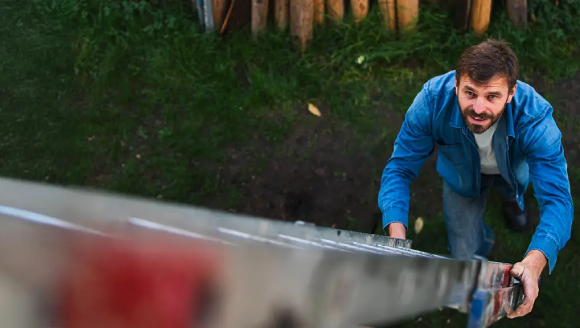Whether you're trimming a hedge, cleaning out a gutter or maintaining your pool, there are electrical hazards lurking behind even the most routine tasks. Here are five things you can do to get the job done without putting your safety at risk.
1. Know the location of all dangerous power lines
Looking up comes less naturally than looking straight ahead or down. And although some power lines are easy to spot, others can be hidden by trees, hedges or buildings. Before starting any yard work, make sure you know exactly where all the nearby power lines are, so you know where the hazards are.
Work accordingly and use the right tools. If a job seems hard to do safely, it's best to call a professional arborist authorized by Hydro‑Québec (in French only).
The 3‑metre rule: Always stay at least 3 metres away from power lines
Any time you're less than 3 metres from a power line, you're putting yourself in danger. You could get a serious or even fatal electric shock. Be sure to keep yourself, your tools and your equipment at least 3 metres away from any power lines at all times.
2. Plan your movements and secure the work area
Ladders, long-reach pruners and extendable hedge trimmers can make your work a lot easier. But they can also bring you closer to power lines. One false move, a gust of wind, a tool held with fully extended arms or ground that's uneven or slippery from rain is sometimes all it takes to bring you dangerously close to a power line.
Before you move, always visualize where your whole body is in space—not just your hands–and where you're going.

3. Think before you work with conductive material
Aluminum ladders, rebar and metal stakes can all transmit electricity at the slightest touch, even through indirect contact.
To reduce the risks of working with conductive objects:
- Always use non‑conductive tools or materials, such as a fibreglass ladder.
- Carry ladders and long tools horizontally to maintain a minimum safe distance of three metres from power lines.
- Never lean a ladder or tool under a power line if it is less than three metres away.
Did you know?
Most serious electrocutions are caused by a lack of awareness of electrical hazards and could be avoided.
4. Before you dig, know what's underground
Not all power lines run overhead. Some are buried, and not always very far down.
Before using digging equipment to install a
pool or any other structure, submit a request to Info‑excavation . It's free!
. It's free!
5. Never plug in electrical equipment when the ground is wet
Water is an extremely good conductor of electricity. Wet grass, an extension cord placed on damp ground or work near a pool or spa: all of these can transform a simple task into a tragedy.
To keep hazards to a minimum:
- Wait until the ground is dry or wear appropriate footwear;
- Avoid working near power lines when the air is humid;
- Use protected outdoor outlets (GFCI);
- Make sure your extension cords are not damaged and that the insulation is not cracked;
- Choose extension cords designed for outdoor use.
Taking the time to check: An essential habit
Don't underestimate the dangers of rain. Take the time to do a proper safety check. And don't hesitate to call in a pro whenever you need one. These simple, essential habits will help keep you safe, so you can focus on enjoying the results of all your hard work.



